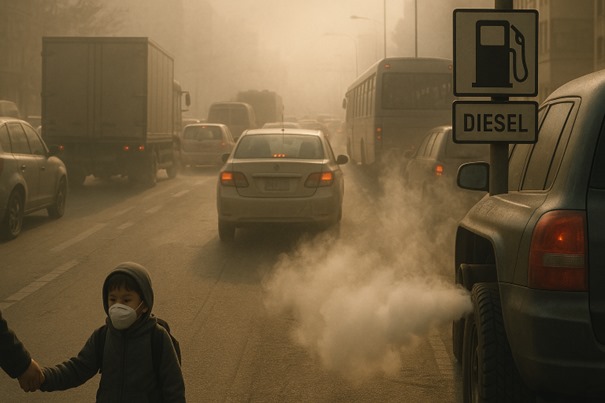For over a century, gasoline and diesel have powered the global economy. From cars and trucks to ships and construction equipment, fossil fuels have driven progress, mobility, and modern convenience. But beneath the surface of that progress lies a quieter, darker legacy — one that pollutes the air we breathe, poisons ecosystems, and quietly erodes human health.
Despite advances in engine efficiency and emissions controls, the pollutants released by burning diesel and gasoline remain among the most harmful airborne contaminants known to science. And while electric vehicles (EVs) gain ground, fossil fuels still dominate global transportation — meaning their consequences are far from behind us.
This article dives into the chemical reality of what's in your fuel, what happens when it burns, and why it's not just carbon dioxide we should be worried about.
1. The Chemical Composition of Diesel and Gasoline
Both diesel and gasoline are derived from crude oil, but they differ significantly in structure and behavior:
- Gasoline is lighter and more volatile, composed primarily of hydrocarbons in the C4–C12 range.
- Diesel is heavier, made up of hydrocarbons in the C10–C20 range, and burns at a higher temperature with greater energy density.
To improve performance and meet regulations, both fuels are treated with additives and refined chemicals. But regardless of formulation, when burned in an internal combustion engine, they release a cocktail of toxic byproducts into the atmosphere.
2. Major Pollutants Released During Combustion
Carbon Monoxide (CO)
Produced by incomplete combustion, carbon monoxide is a colorless, odorless gas that binds to hemoglobin in the blood more effectively than oxygen. High exposure can lead to headaches, confusion, and even death in enclosed spaces.
Nitrogen Oxides (NO and NO₂ – collectively NOₓ)
These reactive gases are produced when high engine temperatures force nitrogen and oxygen to combine. NOₓ contributes to:
- Respiratory illnesses
- Asthma aggravation
- Ground-level ozone (smog) formation
- Acid rain
Diesel engines are particularly notorious for NOₓ emissions due to their high-pressure combustion processes.
Particulate Matter (PM)
One of the most dangerous pollutants, PM2.5 and PM10 are microscopic particles that penetrate deep into lung tissue and enter the bloodstream. Diesel exhaust is a major source. These particles can carry:
- Heavy metals
- Carcinogens
- Hydrocarbons
Chronic exposure to PM is linked to heart disease, stroke, lung cancer, and developmental issues in children.
Volatile Organic Compounds (VOCs)
These include compounds like benzene, toluene, xylene, and formaldehyde. VOCs are emitted from fuel evaporation, incomplete combustion, and tailpipe exhaust. Many are toxic, carcinogenic, and contribute to ozone formation.
Sulfur Dioxide (SO₂)
Although ultra-low sulfur fuels have reduced SO₂ emissions in recent years, it is still a concern in regions using older diesel. SO₂ is a precursor to acid rain, damages vegetation, and irritates the lungs.
Polycyclic Aromatic Hydrocarbons (PAHs)
Formed during incomplete combustion, PAHs are persistent organic pollutants that accumulate in soil, water, and food chains. Many are classified as probable human carcinogens.
3. The Human Cost: Health Impacts of Fossil Fuel Pollution
Numerous peer-reviewed studies have confirmed the devastating health effects of combustion-based pollution:
- According to the World Health Organization, air pollution from transport contributes to 7 million premature deaths annually worldwide.
- Diesel exhaust has been officially classified as a Group 1 carcinogen by the International Agency for Research on Cancer (IARC).
- Long-term exposure to traffic-related air pollution is linked to cognitive decline, low birth weight, chronic bronchitis, and reduced lung function in children.
Communities near highways and urban traffic corridors — often low-income — suffer the most intense exposure.
4. Environmental Fallout: Beyond Human Health
The combustion of diesel and gasoline contributes heavily to:
- Greenhouse gas emissions, especially CO₂
- Climate change-induced weather extremes
- Ocean acidification, via carbon emissions
- Soil and water contamination, through oil runoff and airborne deposition
- Biodiversity loss, as toxic compounds accumulate in plants, animals, and aquatic systems
It's a full-spectrum environmental assault — and one that continues as long as combustion-based transport remains the norm.
5. Technological Mitigations — And Their Limits
Efforts have been made to curb emissions:
- Catalytic converters reduce CO and NOₓ in gasoline engines
- Diesel Particulate Filters (DPFs) trap PM
- Selective Catalytic Reduction (SCR) systems lower NOₓ
- Reformulated fuels with lower sulfur and benzene
Yet none of these technologies eliminate pollution completely — they only reduce it under optimal conditions, often degrading with age or failing in real-world driving (as exposed by the Dieselgate scandal).
6. The Transition Challenge: Why Change Is Slow
Despite the known dangers, internal combustion remains dominant due to:
- Massive global infrastructure built around oil
- High upfront costs of EV adoption
- Inertia in political will and public behavior
- Fossil fuel lobbying and disinformation
As a result, millions of combustion engines are still being sold yearly — ensuring the continuation of pollution for decades to come.
Conclusion: A Hidden Crisis with Visible Consequences
While climate change dominates headlines, the toxic byproducts of fuel combustion pose a more immediate and personal threat to human health and urban sustainability. Unlike CO₂, which acts over decades, pollutants like PM and NOₓ affect your lungs today, your children's lungs tomorrow, and your city's livability forever.
Ending our dependence on diesel and gasoline isn't just about reducing carbon — it's about clearing the air we breathe, protecting the most vulnerable, and healing the ecosystems we've compromised.
Until then, every engine that starts — every ignition that roars — continues to add to a quiet, invisible toll.
And the cost is far higher than we've been led to believe.



